HONDA FR-V User Manual

06/10/30 16:41:48 32SJD620_001
This owner’s manual should be considered a permanent part of the vehicle and should remain with the vehicle when it is sold.
This owner’s manual covers all versions. Therefore, you may find descriptions of equipment and features that are not on your particular vehicle.
The information and specifications included in this publication were in effect at the time of approval for printing. Honda Motor Co., Ltd. reserves the right, however, to discontinue or change specifications or design at any time without notice and without incurring any obligation whatsoever.
Although this manual is applicable to both right-hand and left-hand drive models, the illustrations contained in this manual mainly refer to the left-hand drive models.

06/10/30 16:41:57 32SJD620_002
Introduction
Congratulations! Your selection was a wise investment. It will give you years of driving pleasure.
One of the best ways to enhance the enjoyment of your new vehicle is to read this manual. In it, you will learn how to operate its driving controls and convenience items. Afterwards, keep this owner’s manual in your vehicle so you can refer to it at any time.
Several other booklets explain the warranties that protect your new vehicle. Read the Service Book/warranty booklet thoroughly so you understand the coverages and are aware of your rights and responsibilities.
Maintaining your vehicle according to the schedules given in this manual or the separate service information booklet helps to keep your driving troublefree while it preserves your investment. When your vehicle needs maintenance, keep in mind that your dealer’s staff is specially trained in servicing the many systems unique to your vehicle. Your dealer is dedicated to your satisfaction and will be pleased to answer any questions and concerns.
Best wishes and happy motoring.
Symbols 
 on labels attached to your vehicle are to remind you to read this owner’s manual for proper and safe operation of your vehicle.
on labels attached to your vehicle are to remind you to read this owner’s manual for proper and safe operation of your vehicle.
As you read this manual, you will find information that is preceded by a  symbol. This information is intended to help you avoid damage to your vehicle, other property, or the environment.
symbol. This information is intended to help you avoid damage to your vehicle, other property, or the environment.
(On German type)
1.Mounting the front licence plate: Mount the front licence plate to the provided holder taking care that the upper edge of the licence plate does not project above the upper surface of the bumper.
2.Mounting the rear licence plate: Mount the rear licence plate to the back of the vehicle so that its lower edge is flush with the lower end of the surface provided for mounting.
i

06/10/30 16:42:08 32SJD620_003
A Few Words About Safety
Your safety, and the safety of others, is very important. And operating this vehicle safely is an important responsibility.
To help you make informed decisions about safety, we have provided operating procedures and other information on labels and in this manual. This information alerts you to potential hazards that could hurt you or others.
Of course, it is not practical or possible to warn you about all the hazards associated with operating or maintaining your vehicle. You must use your own good judgement.
You will find this important safety information in a variety of forms, including:
 Safety Labels on the vehicle.
Safety Labels on the vehicle.
 Safety Messages preceded by a safety alert symbol
Safety Messages preceded by a safety alert symbol  and one of three signal words: DANGER, WARNING, or CAUTION.
and one of three signal words: DANGER, WARNING, or CAUTION.
These signal words mean:
You WILL be KILLED or SERIOUSLY
HURT if you don’t follow instructions.
You CAN be KILLED or SERIOUSLY
HURT if you don’t follow instructions.
You CAN be HURT if you don’t follow instructions.
 Safety Headings such as Important Safety Reminders or Important Safety Precautions.
Safety Headings such as Important Safety Reminders or Important Safety Precautions.
 Safety Section such as Driver and Passenger Safety.
Safety Section such as Driver and Passenger Safety.  Instructions how to use this vehicle correctly and safely.
Instructions how to use this vehicle correctly and safely.
This entire book is filled with important safety information please read it carefully.
ii

06/10/30 16:42:21 32SJD620_004
|
|
|
|
|
|
Contents |
|
Turn to the beginning of each section for a complete list of subjects. |
|
|
|
|
|||
Your Vehicle at a Glance |
2 |
|
Before Driving |
183 |
|
Taking Care of the |
|
|
|
|
|||||
Driver and Passenger Safety |
7 |
|
What fuel to use, how to break-in |
|
Unexpected ........................ |
295 |
|
|
your new vehicle, and how to load |
|
This section covers several |
|
|||
Important information about the |
|
luggage and other cargo. |
|
|
problems motorists sometimes |
||
proper use and care of your |
|
|
Driving |
199 |
|
experience, and details how to |
|
vehicle’s seat belts, an overview of |
|
|
handle them. |
|
|||
the supplemental restraint system, |
|
The proper way to start the engine, |
|
Technical Information |
327 |
||
and valuable information on how |
|
shift the transmission, and park; |
|
||||
to protect children with child |
|
|
plus what you need to know if |
|
|
ID numbers, dimensions, |
|
restraints. |
|
|
you’re planning to tow a trailer. |
|
capacities, and technical |
|
|
Instruments and Controls |
69 |
|
Maintenance |
227 |
|
information. |
|
|
|
Index |
341 |
||||
Explains the purpose of each |
|
|
The maintenance schedule shows |
|
|||
instrument panel indicator and |
|
you when you need to take your |
|
|
|
||
gauge, and how to use the controls |
|
vehicle to the dealer. There is also |
|
|
|
||
on the dashboard and steering |
|
a list of things to check and |
|
|
|
|
|
column. |
|
|
instructions on how to check them. |
|
|
|
|
Features............................. |
139 |
|
Appearance Care ................. |
287 |
|
|
|
How to operate the climate control |
|
Tips on cleaning and protecting |
|
|
|
||
system, the audio system, and |
|
|
your vehicle. |
|
|
|
|
other convenience features. |
|
|
|
|
|
|
|
|
|
|
|
|
|
|
|
1
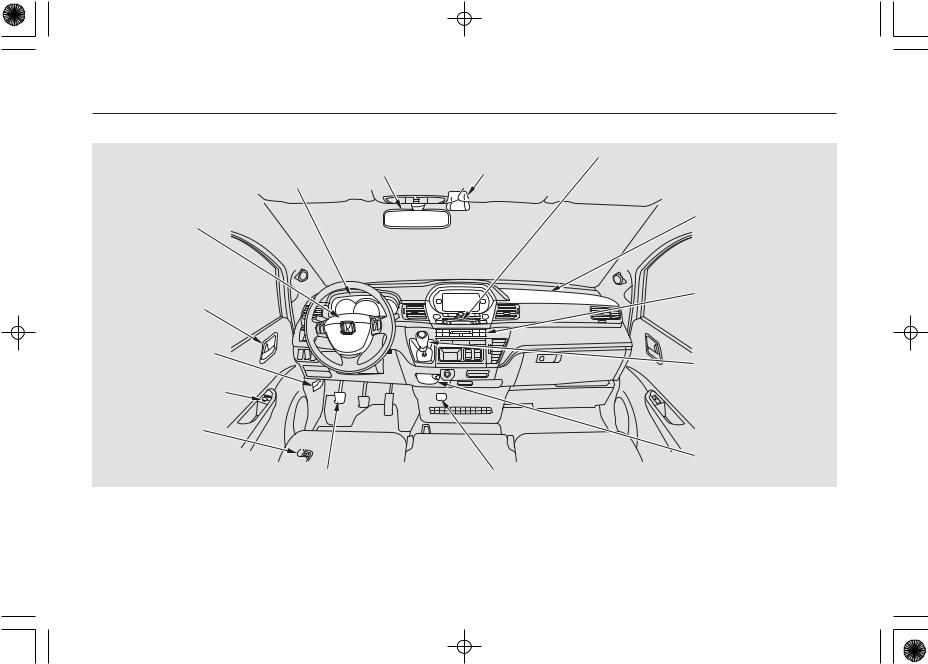
06/10/30 16:42:28 32SJD620_005
Your Vehicle at a Glance
Left-hand drive type INSTRUMENT PANEL |
INSIDE MIRROR |
RAINFALL SENSOR 1 |
AUDIO SYSTEM(P. 148) |
|
INDICATORS (P. 72, 73) |
(P. 126) |
(P. 88) |
CLOCK (P. 174) |
|
GAUGES (P. 81) |
|
|
|
|
DRIVER’S |
|
|
|
PASSENGER’S FRONT |
FRONT AIRBAG |
|
|
|
AIRBAG |
(P. 12, 27) |
|
|
|
(P. 12, 27) |
|
|
|
|
CLIMATE CONTROL |
DOOR LOCK TAB |
|
|
|
SYSTEM |
|
|
|
(P. 140) |
|
(P. 99) |
|
|
|
|
BONNET RELEASE |
|
|
|
MANUAL |
HANDLE (P. 186) |
|
|
|
|
|
|
|
|
TRANSMISSION 3 |
MIRROR CONTROLS |
|
|
|
(P. 204) |
|
|
|
AUTOMATIC |
|
(P. 126) |
|
|
|
|
|
|
|
TRANSMISSION 2 |
|
FUEL FILL DOOR |
|
|
|
(P. 207) |
|
|
|
|
|
RELEASE HANDLE |
|
|
|
|
(P. 185) |
|
|
|
PARKING BRAKE |
PARKING BRAKE PEDAL 2 (P. 129) |
AUXILIARY INPUT JACK 1 |
HANDLE 3 (P. 128) |
||
(P. 176) |
||||
1 : For some types
2 : For automatic transmission models only
3 : For manual transmission models only
2
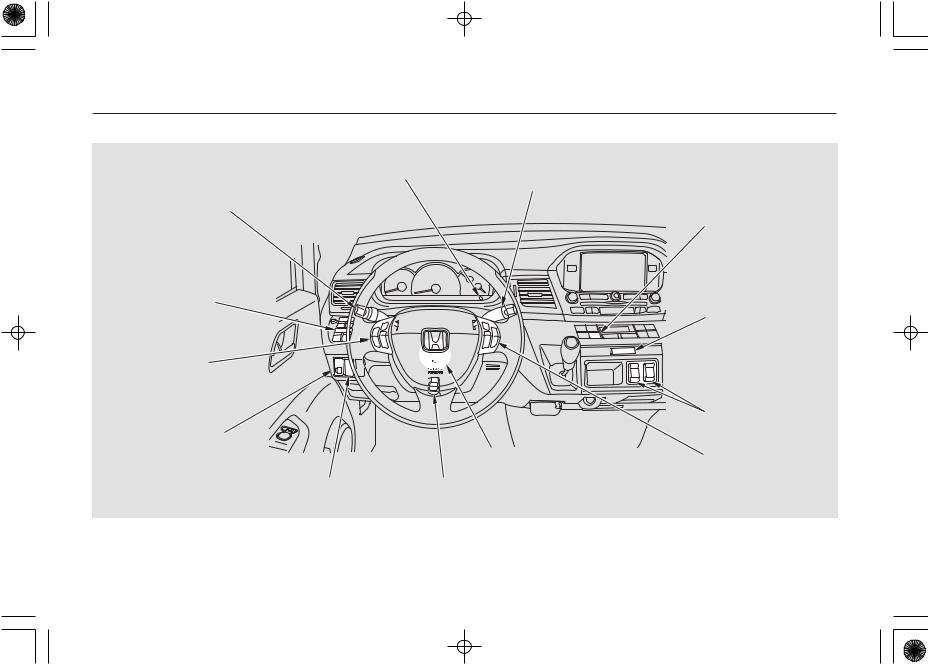
06/10/30 16:42:35 32SJD620_006
|
|
|
|
Your Vehicle at a Glance |
Left-hand drive type |
|
|
|
|
|
INSTRUMENT PANEL BRIGHTNESS |
WINDSCREEN WIPERS/WASHERS |
||
|
(P. 93) |
|
(P. 87) |
|
HEADLIGHTS/TURN |
|
|
|
|
SIGNALS (P. 90) |
|
|
|
REAR WINDOW |
FRONT FOG LIGHTS 2/ |
|
|
|
DEMISTER (P. 94)/ |
REAR FOG LIGHT |
|
|
|
MIRROR HEATERS |
(P. 91) |
|
|
|
BUTTON |
|
|
|
|
(P. 127) |
POWER WINDOW |
|
|
|
|
SWITCHES |
|
|
|
HAZARD WARNING |
(P. 123) |
|
|
|
BUTTON |
|
|
|
|
(P. 94) |
REMOTE AUDIO |
|
|
|
|
CONTROL BUTTONS 2 |
|
|
|
|
(P. 176) |
|
|
|
|
|
|
|
|
SEAT HEATER |
|
|
|
|
SWITCHES 2 |
HEADLIGHT ADJUSTER |
2 |
|
|
(P. 119) |
(P. 122) |
|
|
HORN 1 |
CRUISE CONTROL |
|
|
|
|
BUTTONS 2 |
VEHICLE STABILITY ASSIST |
STEERING WHEEL ADJUSTMENT |
(P. 179) |
||
|
||||
(VSA) OFF SWITCH (P. 218) |
(P. 95) |
|
|
|
1 : To use the horn, press the centre pad of the steering wheel.
2 : For some types
3

06/10/30 16:42:42 32SJD620_007
Your Vehicle at a Glance
Right-hand drive type |
AUDIO SYSTEM(P. 148) |
RAINFALL SENSOR 1 |
INSIDE MIRROR |
INSTRUMENT PANEL |
|
CLOCK (P. 174) |
(P. 88) |
(P. 126) |
INDICATORS(P. 72, 73) |
|
|
|
|
GAUGES(P. 81) |
PASSENGER’S FRONT |
|
|
|
|
AIRBAG |
|
|
|
|
(P. 12, 27) |
|
|
|
|
|
|
|
|
DRIVER’S FRONT |
|
|
|
|
AIRBAG |
CLIMATE CONTROL |
|
|
|
(P. 12, 27) |
|
|
|
|
|
SYSTEM |
|
|
|
DOOR LOCK TAB |
(P. 140) |
|
|
|
|
|
|
|
|
(P. 99) |
MANUAL |
|
|
|
BONNET RELEASE |
TRANSMISSION 3 |
|
|
|
|
(P. 204) |
|
|
|
HANDLE |
|
|
|
(P. 186) |
|
AUTOMATIC |
|
|
|
|
|
|
|
|
|
TRANSMISSION 2 |
|
|
|
MIRROR CONTROLS |
(P. 207) |
|
|
|
(P. 126) |
PARKING BRAKE |
|
|
|
FUEL FILL DOOR |
HANDLE 3 |
|
|
|
RELEASE HANDLE |
(P. 128) |
|
|
|
(P. 185) |
AUXILIARY INPUT JACK 1 (P. 176) |
PARKING BRAKE PEDAL 2 (P. 129) |
|
||
1 : For some types
2 : For automatic transmission models only
3 : For manual transmission models only
4
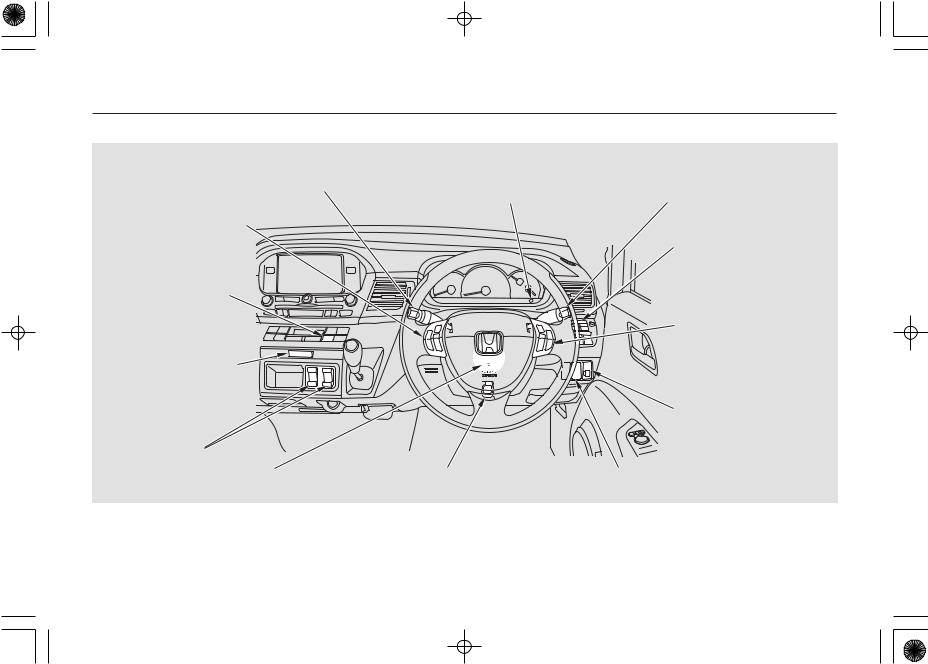
06/10/30 16:42:49 32SJD620_008
|
|
|
|
|
Your Vehicle at a Glance |
Right-hand drive type |
|
|
|
|
|
|
HEADLIGHTS/TURN SIGNALS 1 (P. 90) |
INSTRUMENT PANEL |
WINDSCREEN WIPERS/ |
||
|
FRONT FOG LIGHTS 3/REAR FOG LIGHT 3 |
BRIGHTNESS |
|
WASHERS 1 |
|
|
(P. 91) |
|
(P. 93) |
|
(P. 87) |
REMOTE AUDIO |
|
|
|
|
|
CONTROL BUTTONS 3 |
|
|
|
|
|
(P. 176) |
|
|
|
|
|
|
|
|
|
|
POWER WINDOW |
REAR WINDOW |
|
|
|
|
SWITCHES |
|
|
|
|
(P. 123) |
|
DEMISTER (P. 94)/ |
|
|
|
|
|
MIRROR HEATERS |
|
|
|
|
|
BUTTON |
|
|
|
|
|
(P. 127) |
|
|
|
|
CRUISE CONTROL |
|
|
|
|
|
|
|
|
|
|
|
BUTTONS 3 |
|
|
|
|
|
(P. 179) |
HAZARD WARNING |
|
|
|
|
|
BUTTON |
|
|
|
|
|
(P. 94) |
|
|
|
|
|
|
|
|
|
|
HEADLIGHT ADJUSTER 3 |
|
|
|
|
|
(P. 122) |
SEAT HEATER |
|
|
|
|
|
SWITCHES 3 |
|
|
|
|
|
(P. 119) |
HORN 2 |
STEERING WHEEL ADJUSTMENT |
VEHICLE STABILITY ASSIST |
||
|
|
(P. 95) |
|
(VSA) OFF SWITCH 2 (P. 218) |
|
1 : Except for European models, these switches change locations with each other.2 : To use the horn, press the centre pad of the steering wheel.
3 : For some types
5

06/10/30 16:42:51 32SJD620_009
6
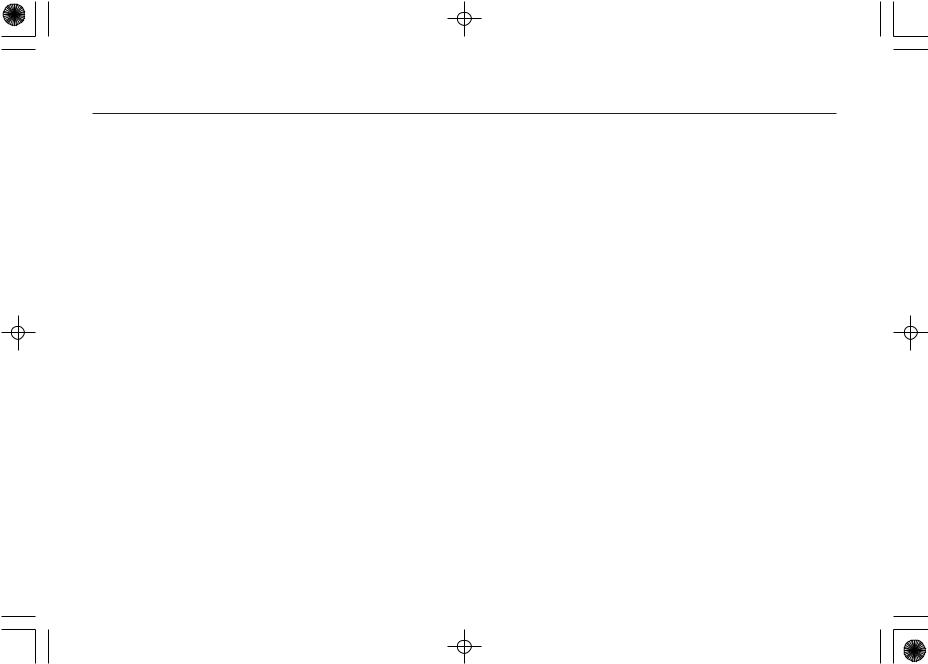
06/10/30 16:42:56 32SJD620_010
Driver and Passenger Safety
This section gives you important |
|
.......................Lap/Shoulder Belt |
21 |
If You Must Drive with Several |
|
information about how to protect |
|
Automatic Seat Belt |
|
Children .................................... |
36 |
yourself and your passengers. It |
|
Tensioners................................ |
23 |
If a Child Requires Close |
|
shows you how to use seat belts. It |
|
Seat Belt Maintenance ................ |
23 |
Attention ................................... |
37 |
explains how your airbags work. And |
Additional Information About |
|
Additional Safety Precautions.... |
37 |
|
it tells you how to properly restrain |
Your Airbags ............................ |
26 |
Protecting Infants and Small |
|
|
infants and children in your vehicle. |
Airbag System Components....... |
26 |
Children .................................... |
39 |
|
Important Safety Precautions |
8 |
How Your Front Airbags |
|
Protecting Infants ........................ |
39 |
Work.......................................... |
27 |
Protecting Small Children .......... |
41 |
||
Your Vehicle’s Safety Features....... |
. 9 |
How Your Side Airbags Work.... |
28 |
Selecting a Child Restraint |
|
Seat Belts ...................................... |
10 |
How Your Side Curtain |
|
System........................................... |
43 |
Airbags.......................................... |
12 |
Airbags Work........................... |
29 |
Installing a Child Restraint |
|
Protecting Adults and Teens.......... |
14 |
How the SRS Indicator Works ... |
30 |
System....................................... |
45 |
1. Close the Doors ....................... |
14 |
Airbag Service.............................. |
30 |
Child Restraint System for EU |
|
2. Adjust the Front Seats ............ |
14 |
Additional Safety Precautions.... |
31 |
Countries .................................. |
46 |
3. Adjust the Seat-Backs ............. |
15 |
Protecting Children General |
|
With the Lower Anchorages ..... |
47 |
4. Adjust the Head Restraints .... |
16 |
Guidelines................................. |
32 |
With a Lap/Shoulder Belt .......... |
52 |
5. Fasten and Position the Seat |
|
All Children Must Be |
|
With a Tether............................... |
57 |
Belts ...................................... |
17 |
Restrained ................................ |
32 |
Protecting Larger Children ............ |
60 |
6. Maintain a Proper Sitting |
|
All Children Should Sit in a |
|
Checking Seat Belt Fit ................ |
61 |
Position ................................. |
18 |
Back Seat .................................. |
33 |
Using a Booster Seat ................... |
61 |
Advice for Pregnant Women...... |
19 |
The Passenger’s Front Airbag |
|
When Can a Larger Child Sit in |
|
Additional Safety Precautions.... |
20 |
Poses Serious Risks................. |
33 |
Front.......................................... |
63 |
Additional Information About Your |
The Side Airbag Poses Serious |
|
Additional Safety Precautions.... |
64 |
|
Seat Belts .................................. |
21 |
Risks.......................................... |
36 |
Carbon Monoxide Hazard .............. |
65 |
Seat Belt System Components... |
21 |
|
|
Safety Labels .................................... |
66 |
Driver and Passenger Safety |
7 |

06/10/30 16:43:06 32SJD620_011
Important Safety Precautions
You’ll find many safety recommendations throughout this section, and throughout this manual. The recommendations on this page are the ones we consider to be the most important.
Always Wear Your Seat Belt
A seat belt is your best protection in all types of collisions. Airbags are designed to supplement seat belts, not replace them. So even though your vehicle is equipped with airbags, make sure you and your passengers always wear your seat belts, and wear them properly (see page 17 ).
Restrain All Children
Children age 12 and under should ride properly restrained in the back seat or the front centre seat. However we recommend positioning children in the back to avoid possible distraction to the driver. Infants and small children should be restrained in a child restraint system. Larger
children should use a booster seat and a lap/shoulder belt until they can use the belt properly without a booster seat (see pages 32 64 ).
Be Aware of Airbag Hazards
While airbags can save lives, they can cause serious or fatal injuries to occupants who sit too close to them, or are not properly restrained. Infants, young children, and short adults are at the greatest risk. Be sure to follow all instructions and warnings in this manual.
Don’t Drink and Drive
Alcohol and driving don’t mix. Even one drink can reduce your ability to respond to changing conditions, and your reaction time gets worse with every additional drink. So don’t drink and drive, and don’t let your friends drink and drive, either.
Control Your Speed
Excessive speed is a major factor in crash injuries and deaths. Generally, the higher the speed, the greater the risk, but serious injuries can also occur at lower speeds. Never drive faster than is safe for current conditions, regardless of the maximum speed posted.
Keep Your Vehicle in Safe Condition
Having a tyre blowout or a mechanical failure can be extremely hazardous. To reduce the possibility of such problems, check your tyre pressures and condition frequently, and perform all regularly scheduled maintenance (see page 229 , and for EU countries and New Zealand, see the Service Book/separate service information booklet that came with your vehicle).
8Driver and Passenger Safety

06/10/30 16:43:13 32SJD620_012
Your Vehicle’s Safety Features
(7) |
(1) |
(8) |
(3) (9) (4) |
(6) |
(5) |
|
(10) |
(9) (2) |
(7) |
(8) |
||
|
|
(11) |
|
|
(1) Safety Cage |
|
|
|
(2) Crush Zones |
|
|
|
(3) Seats and Seat-Backs |
||
|
(4) Head Restraints |
||
|
(5) Collapsible Steering Column |
||
(2) |
(6) Seat Belts |
|
|
(7) Front Airbags |
|
||
|
(8) Side Airbags |
|
|
|
(9) Side Curtain Airbags |
||
: For some types |
(10) Front Seat Belt Tensioners |
||
|
|
|
|
|
(11) Outer Lap Tensioner |
||
Your vehicle is equipped with many features that work together to protect you and your passengers during a crash.
Some features do not require any action on your part. These include a strong steel framework that forms a safety cage around the passenger compartment, front and rear crush zones, a collapsible steering column, and tensioners that tighten the front seat belts in a crash.
However, you and your passengers can’t take full advantage of these features unless you remain sitting in a proper position and always wear your seat belts. In fact, some safety features can contribute to injuries if they are not used properly.
The following pages explain how you can take an active role in protecting yourself and your passengers.
Driver and Passenger Safety |
9 |

06/10/30 16:43:23 32SJD620_013
Your Vehicle’s Safety Features
Seat Belts
Your vehicle is equipped with seat belts in all seating positions.
Your seat belt system also includes an indicator on the instrument panel and a beeper to remind you and your passengers to fasten your seat belts.
Why Wear Seat Belts
Seat belts are the single most effective safety device for adults and larger children. (Infants and smaller children must be properly restrained in child restraint systems.)
Not wearing a seat belt properly increases the chance of serious injury or death in a crash, even though your vehicle has airbags.
In most European Countries there is a law covering the use of seat belts. Please take time to familiarize yourself with the legal requirements of the countries in which you will drive.
Not wearing a seat belt properly increases the chance of serious injury or death in a crash, even though your vehicle has airbags.
Be sure you and your passengers always wear seat belts and wear them properly.
When properly worn, seat belts:
 Keep you connected to the vehicle so you can take advantage of the vehicle’s built-in safety features.
Keep you connected to the vehicle so you can take advantage of the vehicle’s built-in safety features.
 Help protect you in almost every type of crash, including frontal, side, and rear impacts and rollovers.
Help protect you in almost every type of crash, including frontal, side, and rear impacts and rollovers.
 Help keep you from being thrown against the inside of the vehicle and against other occupants.
Help keep you from being thrown against the inside of the vehicle and against other occupants.
 Keep you from being thrown out of the vehicle.
Keep you from being thrown out of the vehicle.
 Help keep you in a good position should the airbags ever deploy. A good position reduces the risk of injury from an inflating airbag and allows you to get the best advantage from the airbag.
Help keep you in a good position should the airbags ever deploy. A good position reduces the risk of injury from an inflating airbag and allows you to get the best advantage from the airbag.
10 Driver and Passenger Safety

06/10/30 16:43:30 32SJD620_014
Your Vehicle’s Safety Features
Of course, seat belts cannot completely protect you in every crash. But in most cases, seat belts can reduce your risk of serious injury.
What You Should Do:
Always wear your seat belt, and make sure you wear it properly.
WARNING:
 Seat belts are designed to bear upon the bony structure of the body, and should be worn low across the front of the pelvis or the pelvis, chest and shoulders, as applicable; wearing the lap section of the belt across the abdominal area must be avoided.
Seat belts are designed to bear upon the bony structure of the body, and should be worn low across the front of the pelvis or the pelvis, chest and shoulders, as applicable; wearing the lap section of the belt across the abdominal area must be avoided.
 Seat belts should be adjusted as firmly as possible, consistent with comfort, to provide the protection for which they have been designed. A slack belt will greatly reduce the protection afforded to the wearer.
Seat belts should be adjusted as firmly as possible, consistent with comfort, to provide the protection for which they have been designed. A slack belt will greatly reduce the protection afforded to the wearer.
 Belts should not be worn with straps twisted.
Belts should not be worn with straps twisted.
 Each belt assembly must only be used by one occupant; it is dangerous to put a belt around a child being carried on the occupant’s lap.
Each belt assembly must only be used by one occupant; it is dangerous to put a belt around a child being carried on the occupant’s lap.
Driver and Passenger Safety 11

06/10/30 16:43:37 32SJD620_015
Your Vehicle’s Safety Features
Airbags
Your vehicle has a Supplemental Restraint System (SRS) with front airbags to help protect the heads and chests of the driver and front seat passengers during a moderate to severe frontal collision (see page
27 for more information on how your front airbags work).
Your vehicle also has side airbags to help protect the upper torso of the driver and the front outer seat passenger during a moderate to severe side impact (see page 28 for more information on how your side airbags work).
In addition, your vehicle has side curtain airbags to help protect the heads of the driver, the front outer seat passenger and the rear outer seat passengers. (See page 29 for more information on how your side curtain airbags work.)
12 Driver and Passenger Safety

06/10/30 16:43:44 32SJD620_016
Your Vehicle’s Safety Features
The most important things you need to know about your airbags are:
 Airbags do not replace seat belts.
Airbags do not replace seat belts.
They are designed to supplement the seat belts.
 Airbags offer no protection in rear impacts, or minor frontal or side collisions.
Airbags offer no protection in rear impacts, or minor frontal or side collisions.
 Airbags can pose serious hazards.
Airbags can pose serious hazards.
To do their job, airbags must inflate with tremendous force. So while airbags help save lives, they can cause minor injuries or more serious or even fatal injuries if occupants are not properly restrained or sitting properly.
What you should do: Always wear your seat belt properly, and sit upright, and as far back from the steering wheel while allowing full control of the vehicle. The front passengers should move their seat as far back from the dashboard as possible.
The rest of this section gives more detailed information about how you can maximize your safety.
Remember, however, that no safety system can prevent all injuries or deaths that can occur in severe crashes, even when seat belts are properly worn and the airbags deploy.
Driver and Passenger Safety 13
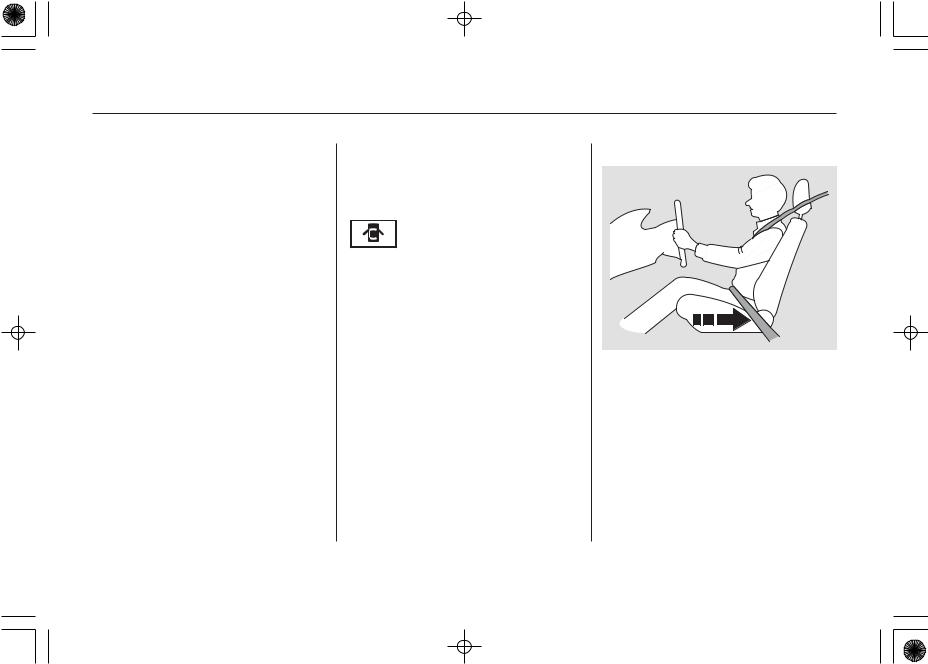
06/10/30 16:43:53 32SJD620_017
Protecting Adults and Teens
Introduction
The following pages provide instructions on how to properly protect the driver, adult passengers, and teenage children who are large enough and mature enough to drive or ride in the front.
See pages 32 38 for important guidelines on how to properly protect infants, small children, and larger children who ride in your vehicle.
1.Close the Doors
After everyone has entered the vehicle, be sure the doors and the tailgate are closed.
Your vehicle has a dooropen indicator on the
instrument panel to indicate when a specific door or the tailgate is not tightly closed.
See page 77 for how the door-open indicator works.
2.Adjust the Front Seats
Adjust the driver’s seat as far to the rear as possible while allowing you to maintain full control of the vehicle. Have front passengers adjust their seats as far to the rear as possible.
If you sit too close to the steering wheel or dashboard, you can be seriously injured by an inflating front airbag, or by striking the steering wheel or dashboard.
14 Driver and Passenger Safety
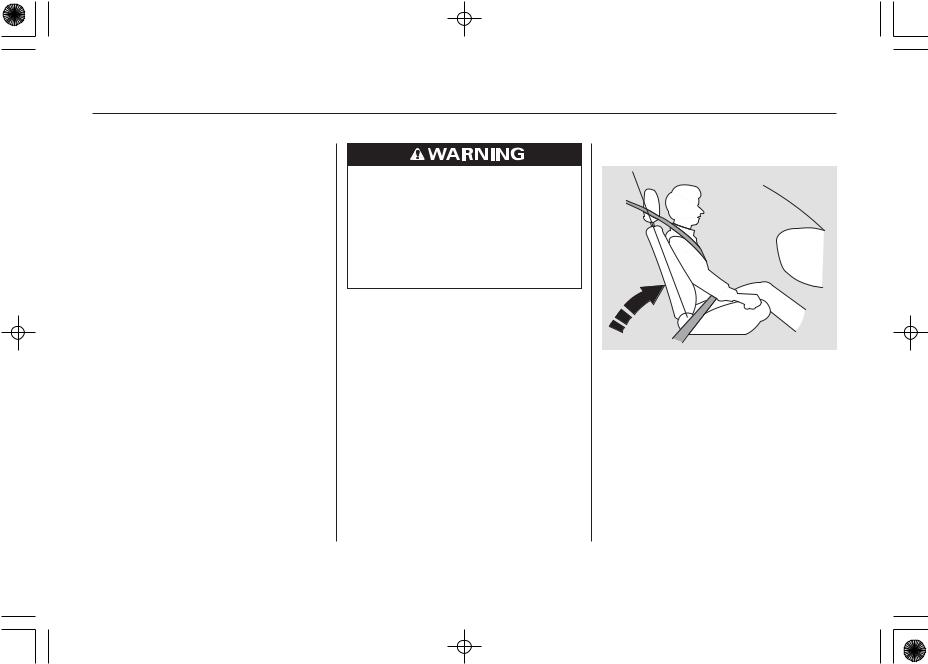
06/10/30 16:44:01 32SJD620_018
Protecting Adults and Teens
In addition to adjusting the seat, you can adjust the steering wheel up and down, and in and out (see page 95 ).
If you cannot get far enough away from the steering wheel and still reach the controls, we recommend that you investigate whether some type of adaptive equipment may help.
Sitting too close to a front airbag can result in serious injury or death if the front airbags inflate.
Always sit as far back from the front airbags as possible.
Once a seat is adjusted correctly, rock it back and forth to make sure it is locked in position.
See page 108 for how to adjust the front seats.
3.Adjust the Seat-Backs
Adjust the driver’s seat-back to a comfortable, upright position, leaving ample space between your chest and the airbag cover in the centre of the steering wheel.
Passengers with adjustable seatbacks should also adjust their seatback to a comfortable, upright position.
CONTINUED
Driver and Passenger Safety 15
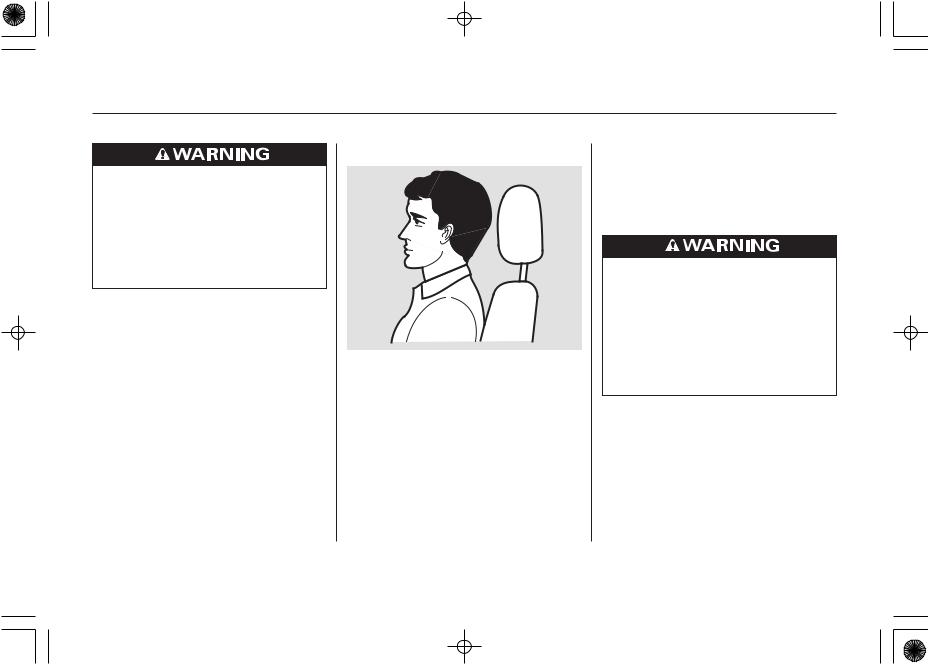
06/10/30 16:44:10 32SJD620_019
Protecting Adults and Teens
Reclining the seat-back too far can result in serious injury or death in a crash.
Adjust the seat-back to an upright position, and sit well back in the seat.
Reclining a seat-back so that the shoulder part of the belt no longer rests against the occupant’s chest reduces the protective capability of the belt. It also increases the chance of sliding under the belt in a crash and being seriously injured. The farther a seat-back is reclined, the greater the risk of injury.
See page 108 for how to adjust the seat-backs.
4.Adjust the Head Restraints
Adjust the driver’s head restraint so the back of your head rests against the centre of the restraint.
Have passengers with adjustable head restraints adjust their restraints properly as well. Taller persons should adjust their restraint as high as possible.
When you use the rear seat, adjust the head restraint to the highest position by pulling it upward. You cannot use this head restraint in the lower position.
Improperly positioning head restraints reduces their effectiveness and you can be seriously injured in a crash.
Make sure head restraints are in place and positioned properly before driving.
Properly adjusted head restraints will help protect occupants from whiplash and other crash injuries.
See page 110 for how to adjust the head restraints.
16 Driver and Passenger Safety
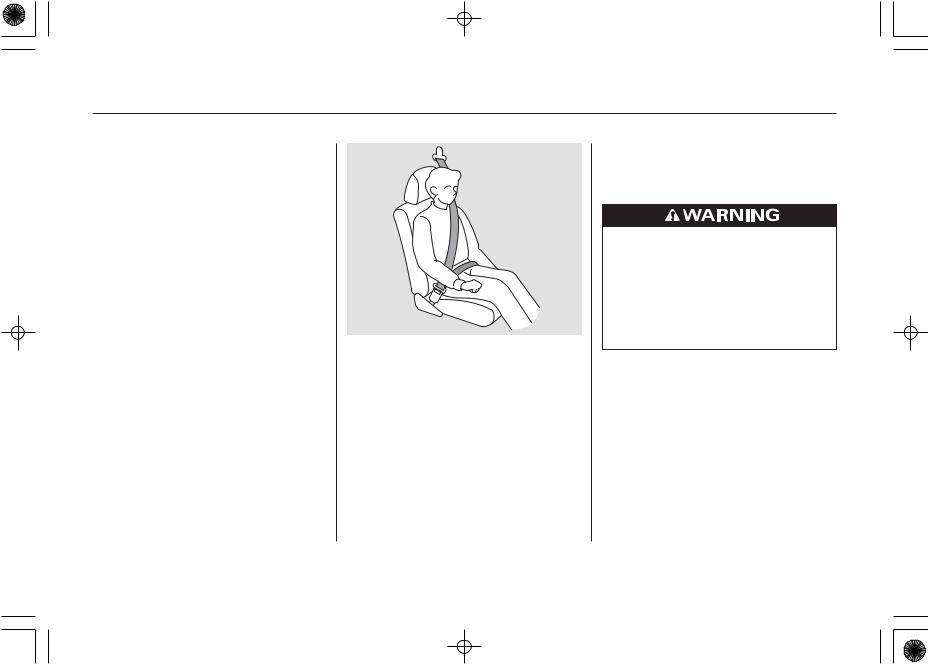
06/10/30 16:44:18 32SJD620_020
Protecting Adults and Teens
5.Fasten and Position the Seat Belts
Insert the latch plate into the buckle, then tug on the belt to make sure the belt is securely latched. Also check that the belt is not twisted, because a twisted belt can cause serious injuries in a crash.
Position the lap part of the belt as low as possible across your hips, then pull up on the shoulder part of the belt so the lap part fits snugly. This lets your strong pelvic bones take the force of a crash and reduces the chance of internal injuries.
If necessary, pull up on the shoulder belt again to remove any slack, then check that the belt rests across the centre of your chest and over your shoulder.
This spreads the forces of a crash over the strongest bones in your upper body.
Improperly positioning the seat belts can cause serious injury or death in a crash.
Make sure all seat belts are properly positioned before driving.
If the seat belt touches or crosses your neck, or if it crosses your arm instead of your shoulder, you need to adjust the seat belt anchor height.
CONTINUED
Driver and Passenger Safety 17

06/10/30 16:44:26 32SJD620_021
Protecting Adults and Teens
RELEASE BUTTONS
The front outer passenger seat and the driver’s seat have adjustable seat belt anchors. To adjust the height of the anchor, press and hold the release buttons and slide the anchor up or down as needed (it has four positions).
Never place the shoulder portion of a lap/shoulder belt under your arm or behind your back. This could cause very serious injuries in a crash.
If a seat belt does not seem to work properly, it may not protect the occupant in a crash.
No one should sit in a seat with an inoperative seat belt. Using a seat belt that is not working properly can result in serious injury or death. Have your dealer check the belt as soon as possible.
See page 21 for additional information about your seat belts and how to take care of them.
6.Maintain a Proper Sitting Position
After all occupants have adjusted their seats and put on seat belts, it is very important that they continue to sit upright, well back in their seats, with their feet on the floor, until the vehicle is parked and the engine is off.
Sitting improperly can increase the chance of injury during a crash. For example, if an occupant slouches, lies down, turns sideways, sits forward, leans forward or sideways, or puts one or both feet up, the chance of injury during a crash is greatly increased.
In addition, an occupant who is out of position in the front seat can be seriously or fatally injured in a crash by striking interior parts of the vehicle or being struck by an inflating front airbag.
18 Driver and Passenger Safety

06/10/30 16:44:33 32SJD620_022
Protecting Adults and Teens
If a front outer seat passenger leans sideways and his head is in the deployment path of the side airbag, an inflating side airbag can strike the passenger with enough force to very seriously injure him.
Sitting improperly or out of position can result in serious injury or death in a crash.
Always sit upright, well back in the seat, with your feet on the floor.
Advice for Pregnant Women
If you are pregnant, the best way to protect yourself and your unborn child when driving or riding in a vehicle is to always wear a seat belt, and keep the lap part of the belt as low as possible across the hips.
When driving, remember to sit upright and adjust the seat as far back as possible while allowing full control of the vehicle. When riding as a front passenger, adjust the seat as far back as possible.
This will reduce the risk of injuries to both you and your unborn child that can be caused by a crash or an inflating front airbag.
Each time you have a checkup, ask your doctor if it’s okay for you to drive.
Driver and Passenger Safety 19
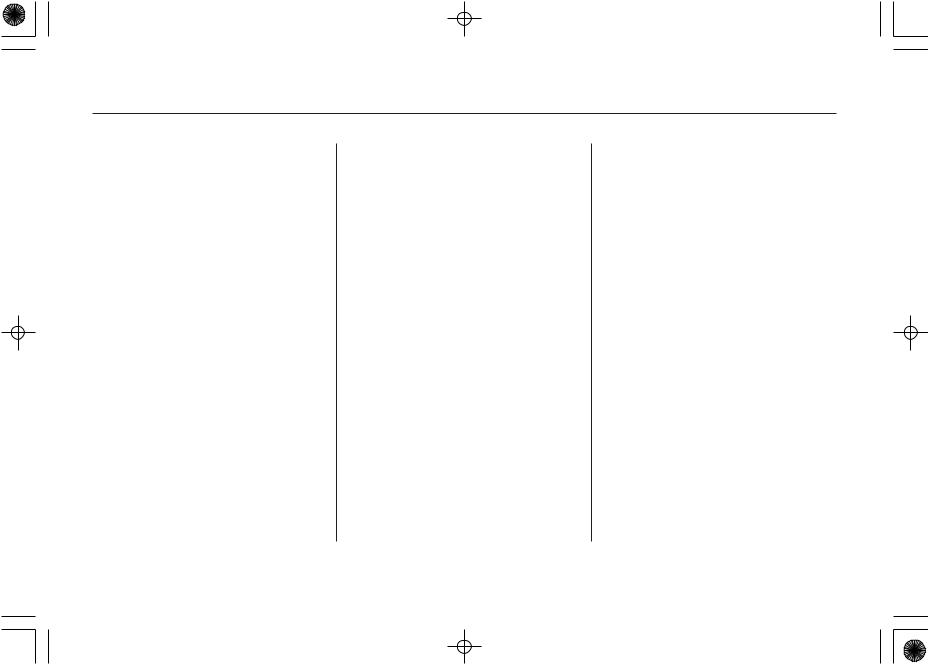
06/10/30 16:44:42 32SJD620_023
Protecting Adults and Teens
Additional Safety Precautions
 Never let passengers ride in the luggage area or on top of a foldeddown back seat. All passengers must sit in locked, upright seats and be properly restrained by seat belts.
Never let passengers ride in the luggage area or on top of a foldeddown back seat. All passengers must sit in locked, upright seats and be properly restrained by seat belts.
 Passengers should not stand up or change seats while the vehicle is moving. A passenger who is not wearing a seat belt during a crash or emergency stop can be thrown against the inside of the vehicle, against other occupants, or out of the vehicle.
Passengers should not stand up or change seats while the vehicle is moving. A passenger who is not wearing a seat belt during a crash or emergency stop can be thrown against the inside of the vehicle, against other occupants, or out of the vehicle.
 Two people should never use the same seat belt. If they do, they could be very seriously injured in a crash.
Two people should never use the same seat belt. If they do, they could be very seriously injured in a crash.
 Do not put any accessories on seat belts. Devices intended to improve occupant comfort or reposition the shoulder part of a seat belt can reduce the protective capability of the seat belt and increase the chance of serious injury in a crash.
Do not put any accessories on seat belts. Devices intended to improve occupant comfort or reposition the shoulder part of a seat belt can reduce the protective capability of the seat belt and increase the chance of serious injury in a crash.
 Do not place hard or sharp objects between yourself and a front airbag. Carrying hard or sharp objects on your lap, or driving with a pipe or other sharp object in your mouth, can result in injuries if your front airbag inflates.
Do not place hard or sharp objects between yourself and a front airbag. Carrying hard or sharp objects on your lap, or driving with a pipe or other sharp object in your mouth, can result in injuries if your front airbag inflates.
 Keep your hands and arms away from the airbag covers. If your hands or arms are close to an
Keep your hands and arms away from the airbag covers. If your hands or arms are close to an
airbag cover, they could be injured if the airbag inflates.
 Do not attach or place objects on the front airbag covers. Objects on the covers marked ‘‘SRS AIRBAG’’ could interfere with the proper operation of the airbags or be propelled inside the vehicle and hurt someone if the airbags inflate.
Do not attach or place objects on the front airbag covers. Objects on the covers marked ‘‘SRS AIRBAG’’ could interfere with the proper operation of the airbags or be propelled inside the vehicle and hurt someone if the airbags inflate.
 Do not attach hard objects on or near a door. If a side airbag or a side curtain airbag inflates, a cup holder or other hard object attached on or near the door could be propelled inside the vehicle and hurt someone.
Do not attach hard objects on or near a door. If a side airbag or a side curtain airbag inflates, a cup holder or other hard object attached on or near the door could be propelled inside the vehicle and hurt someone.
 Do not put a coat hanger or hard objects on a coat hook. This could result in injuries if your side curtain airbag inflates.
Do not put a coat hanger or hard objects on a coat hook. This could result in injuries if your side curtain airbag inflates.
20 Driver and Passenger Safety
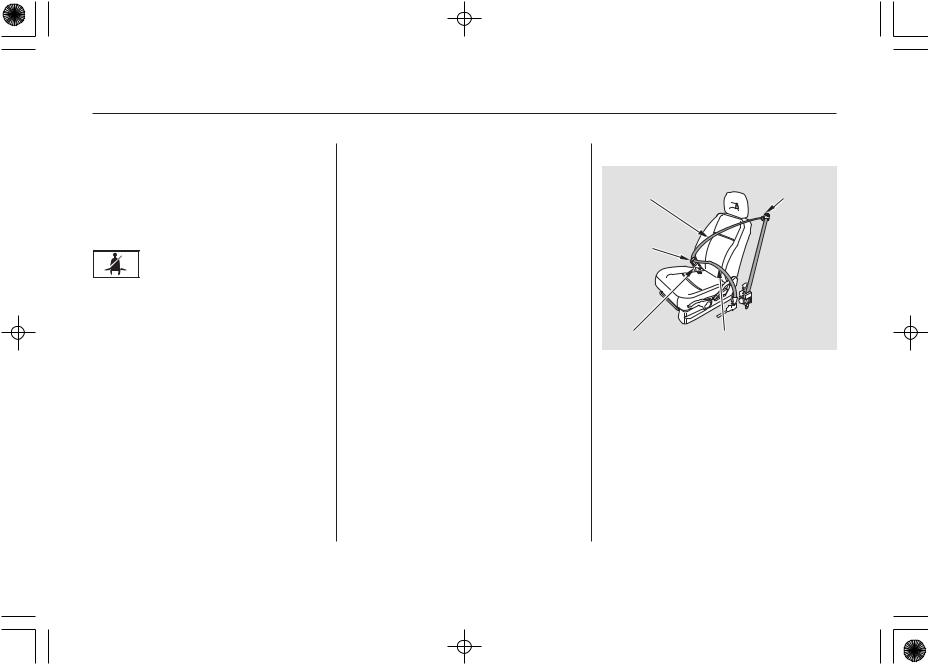
06/10/30 16:44:50 32SJD620_024
Additional Information About Your Seat Belts
Seat Belt System Components
Your seat belt system includes lap/ shoulder belts in all six seating positions. The front seat belts are also equipped with automatic seat belt tensioners.
The seat belt system includes an indicator on the
instrument panel and a beeper to remind you and your passengers to fasten your seat belts.
If you turn the ignition switch to ON (II) without fastening your belt, a beeper will sound and the indicator will blink. The beeper will stop after several seconds, but the indicator will stay on until the driver’s seat belt is fastened.
If you do not fasten your seat belt before the beeper stops, the indicator will stop blinking but remain on. If you continue driving without fastening your seat belt, the indicator will start blinking again and the beeper will sound at regular intervals.
Lap/Shoulder Belt
SHOULDER |
UPPER SEAT |
PORTION |
BELT ANCHOR |
LATCH |
|
PLATE |
|
BUCKLE |
LAP PORTION |
The lap/shoulder belt goes over your shoulder, across your chest, and across your hips.
To fasten the belt, insert the latch plate into the buckle, then tug on the belt to make sure the buckle is latched (see page 17 for how to properly position the belt).
CONTINUED
Driver and Passenger Safety 21

06/10/30 16:44:58 32SJD620_025
Additional Information About Your Seat Belts
To unlock the belt, press the red PRESS button on the buckle. Guide the belt across your body so that it retracts completely. After exiting the vehicle, be sure the belt is out of the way and will not get closed in the door.
All seat belts have an emergency locking retractor. In normal driving, the retractor lets you move freely in your seat while it keeps some tension on the belt. During a collision or sudden stop, the retractor automatically locks the belt to help restrain your body.
The seat belts in all rear seating positions and the front centre seat have an additional lockable retractor that must be activated to secure a child restraint (see page 52 ).
If the shoulder part of the belt is pulled all the way out, the lockable retractor will activate. The belt will retract, but it will not allow the passenger to move freely.
To deactivate the lockable retractor, unlatch the buckle and let the seat belt fully retract. To refasten the seat belt, pull it out only as far as needed.
DETACHABLE ANCHOR
The lap/shoulder belt in the rear centre seat is equipped with a detachable anchor that has two parts: a small latch plate and an anchor buckle.
The detachable seat belt should normally be latched whenever the seat-backs are in an upright position. For more information about the detachable seat belt, see page 117 .
22 Driver and Passenger Safety

06/10/30 16:45:08 32SJD620_026
Additional Information About Your Seat Belts
Automatic Seat Belt Tensioners
OUTER LAP PRETENSIONER: For some types
For added protection, the front seat belts are equipped with automatic seat belt tensioners. When activated, the tensioners immediately tighten the belts to help hold the driver and the front passengers in position.
The tensioners are designed to activate in any collision severe enough to cause the front airbags to deploy.
If a side or side curtain airbag deploys during a side impact, the tensioner on that side of the vehicle will also deploy.
The tensioners can also be activated during a collision in which the front airbags do not deploy. In this case, the airbags would not be needed, but the additional restraint could be helpful.
When the tensioners are activated, the seat belts will remain tight until they are unbuckled.
The SRS indicator will come on if there is a
problem with your automatic seat belt tensioners (see page 30 ).
Seat Belt Maintenance
For safety, you should check the condition of your seat belts regularly.
Pull each belt out fully, and look for frays, cuts, burns, and wear. Check that the latches work smoothly and the belts retract easily. If a belt does not retract easily, cleaning the belt may correct the problem (see page 292 ). Any belt that is not in good condition or working properly will not provide good protection and should be replaced as soon as possible.
WARNING: No modifications or additions should be made by the user which will either prevent the seat belt adjusting devices from operating to remove slack, or prevent the seat belt assembly from being adjusted to remove slack.
CONTINUED
Driver and Passenger Safety 23
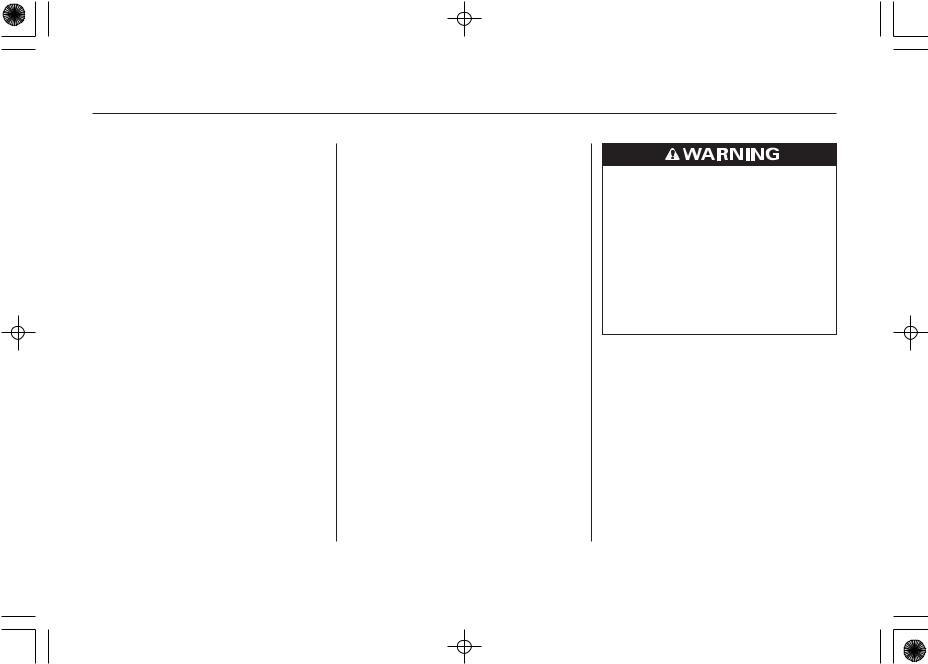
06/10/30 16:45:14 32SJD620_027
Additional Information About Your Seat Belts
If a seat belt is worn during a crash, it must be replaced by the dealer. A belt that has been worn during a crash may not provide the same level of protection in a subsequent crash.
The dealer should also inspect the anchors for damage and replace them if needed. If the automatic seat belt tensioners activate during a crash, they must be replaced.
WARNING: It is essential to replace the entire assembly after it has been worn in a severe impact even if damage to the assembly is not obvious.
WARNING: Care should be taken to avoid contamination of the webbing with polishes, oils and chemicals, and particularly battery acid. Cleaning may safely be carried out using mild soap and water. The belt should be replaced if webbing becomes frayed, contaminated or damaged.
Not checking or maintaining seat belts can result in serious injury or death if the seat belts do not work properly when needed.
Check your seat belts regularly and have any problem corrected as soon as possible.
24 Driver and Passenger Safety
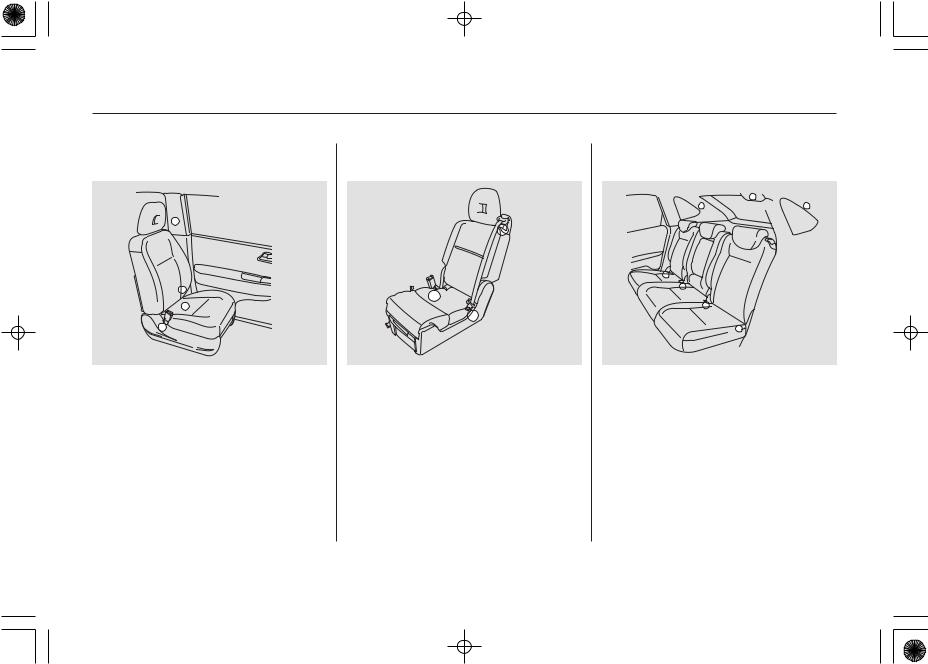
06/10/30 16:45:21 32SJD620_028
Additional Information About Your Seat Belts
Anchorage Points |
|
|
(Front Outer Seat) |
(Front Centre Seat) |
(Rear Seat) |
When replacing the seat belts, make certain to use the anchorage points shown in the illustrations.
The rear seat has three lap/shoulder belts.
Driver and Passenger Safety 25

06/10/30 16:45:30 32SJD620_029
Additional Information About Your Airbags
Airbag System Components
Your airbag system includes:
 Two SRS (supplemental restraint system) front airbags. The driver’s airbag is stored in the centre of the steering wheel; the front passenger’s airbag is stored in the dashboard. Both are marked ‘‘SRS AIRBAG’’ (see page 27 ).
Two SRS (supplemental restraint system) front airbags. The driver’s airbag is stored in the centre of the steering wheel; the front passenger’s airbag is stored in the dashboard. Both are marked ‘‘SRS AIRBAG’’ (see page 27 ).
 Two side airbags, one for the driver and one for the front outer passenger. The airbags are stored in the outer edges of the seatbacks. Both are marked ‘‘SIDE AIRBAG’’ (see page 28 ).
Two side airbags, one for the driver and one for the front outer passenger. The airbags are stored in the outer edges of the seatbacks. Both are marked ‘‘SIDE AIRBAG’’ (see page 28 ).
 Two side curtain airbags, one for each side of the vehicle. The airbags are stored in the ceiling above the side windows. The front and rear pillars on both sides are marked ‘‘SIDE CURTAIN AIRBAG’’ (see page 29 ).
Two side curtain airbags, one for each side of the vehicle. The airbags are stored in the ceiling above the side windows. The front and rear pillars on both sides are marked ‘‘SIDE CURTAIN AIRBAG’’ (see page 29 ).
 Automatic front seat belt tensioners (see page 23 ).
Automatic front seat belt tensioners (see page 23 ).
 Sensors that can detect a moderate to severe front impact or side impact.
Sensors that can detect a moderate to severe front impact or side impact.
 A sophisticated electronic system that continually monitors information about the sensors, the control unit, and the airbag activators when the ignition switch is in the ON (II) position.
A sophisticated electronic system that continually monitors information about the sensors, the control unit, and the airbag activators when the ignition switch is in the ON (II) position.
 An indicator on the instrument panel that alerts you to a possible problem with your airbags, sensors, or seat belt tensioners (see page 30 ).
An indicator on the instrument panel that alerts you to a possible problem with your airbags, sensors, or seat belt tensioners (see page 30 ).
 Emergency backup power in case your vehicle’s electrical system is disconnected in a crash.
Emergency backup power in case your vehicle’s electrical system is disconnected in a crash.
26 Driver and Passenger Safety

06/10/30 16:45:38 32SJD620_030
Additional Information About Your Airbags
How Your Front Airbags Work
If you ever have a moderate to severe frontal collision, sensors will detect the vehicle’s rapid deceleration.
If the rate of deceleration is high enough, the control unit will instantly inflate the driver’s and front passengers’ front airbags, and activate the automatic seat belt tensioners.
During a frontal crash, your seat belt restrains your lower body and torso, while the tensioner tightens and locks the seat belt to help keep you in place, and the airbag helps protect your head and chest.
Although both airbags normally inflate within a split second of each other, it is possible for only one airbag to deploy.
This can happen if the severity of a collision is at the margin, or threshold, that determines whether or not the airbags will deploy. In such cases, the seat belt will provide sufficient protection, and the supplemental protection offered by the airbag would be minimal.
After inflating, the front airbags will immediately deflate, so they won’t interfere with the driver’s visibility, or the ability to steer or operate other controls.
CONTINUED
Driver and Passenger Safety 27
